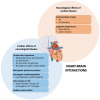The Heart-Brain Axis: Key Concepts in Neurocardiology
- PMID: 40535756
- PMCID: PMC12173172
- DOI: 10.1097/CD9.0000000000000156
The Heart-Brain Axis: Key Concepts in Neurocardiology
Abstract
The heart-brain axis involves complex interactions between the cardiovascular and nervous systems via a network of cortical and subcortical structures working with the autonomic nervous system and intracardiac nervous system. Heart-brain interactions may be divided into 2 broad categories: cardiac effects of neurological disease and neurological effects of cardiac disease. The pathogenesis of neurogenic cardiac effects is thought to involve a neurogenic cascade where sudden shifts in autonomic balance lead to an exaggerated catecholamine release. This can occur in acute neurological conditions such as ischemic stroke, intracranial hemorrhage, and epilepsy. Cardiovascular complications include the stroke-heart syndrome, neurogenic pulmonary edema and cardiomyopathy, Takotsubo syndrome, arrhythmias, and even sudden cardiac death. Certain areas of the brain, such as the insular cortex, play key roles in cardiac autonomic regulation, and disorders affecting these areas have greater effects on the heart. On the other hand, cardiac conditions can also adversely impact the neurological system. Atrial fibrillation and left ventricular thrombus can cause cardioembolic strokes, whereas heart failure and severe aortic stenosis have been linked to the development of cognitive impairment. This review aims to provide a broad overview of key topics in neurocardiology as well as delve into the evidence and pathophysiology behind these conditions.
Keywords: Atrial fibrillation; Autonomic nervous system; Cardiovascular system; Cognitive dysfunction; Heart-brain axis; Neurocardiology; Stroke-heart syndrome.
Copyright © 2025 The Chinese Medical Association, published by Wolters Kluwer Health, Inc.
Conflict of interest statement
None.
Figures




References
-
- Cannon WB. “Voodoo” death. Am Anthropol 1942;44(2):169–181. doi:10.1525/aa.1942.44.2.02a00010.
-
- Engel GL. Sudden and rapid death during psychological stress. Folklore or folk wisdom. Ann Intern Med 1971;74(5):771–782. doi:10.7326/0003-4819-74-5-771. - PubMed
-
- Steinberg JS Arshad A Kowalski M, et al. Increased incidence of life-threatening ventricular arrhythmias in implantable defibrillator patients after the World Trade Center attack. J Am Coll Cardiol 2004;44(6):1261–1264. doi:10.1016/j.jacc.2004.06.032. - PubMed
-
- Tahsili-Fahadan P, Geocadin RG. Heart-Brain Axis: Effects of Neurologic Injury on Cardiovascular Function. Circ Res 2017;120(3):559–572. doi:10.1161/CIRCRESAHA.116.308446. - PubMed
Publication types
LinkOut - more resources
Full Text Sources
